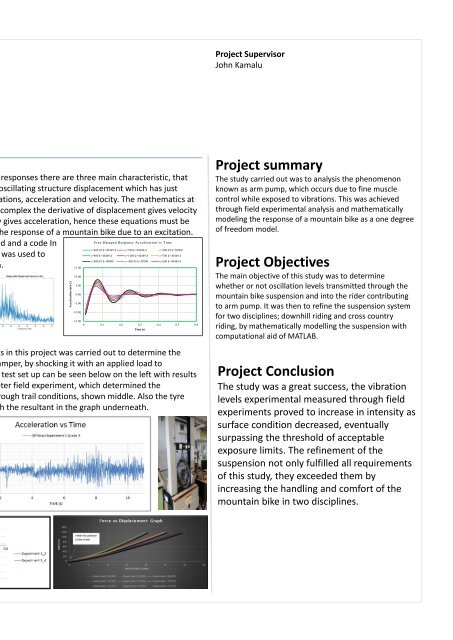UWE Bristol Engineering showcase 2015
You also want an ePaper? Increase the reach of your titles
YUMPU automatically turns print PDFs into web optimized ePapers that Google loves.
Billy Nightingale<br />
BEng (Hons) Motorsport <strong>Engineering</strong><br />
Project Supervisor<br />
John Kamalu<br />
Reducing the Fatigue of Mountain Bike Rider<br />
Introduction<br />
The project was approximately weight 70% theoretical analysis and 30%<br />
practical. The overall focus of this study is to determine if the vibrations<br />
transmitted from rough trail conditions contribute to the phenomenon<br />
known as arm pump, this will be achieved through experiments. Arm<br />
pump is when the muscles within the forearm closes around the blood<br />
vessels and causes the arm to fatigue. The the suspension<br />
system will be mathematically model as a one degree of<br />
freedom model to analysis the theoretical response and<br />
improve the suspension system. To understand the response<br />
of the system the variables that make up the suspension<br />
system must be understood such as spring stiffness k, damping<br />
coefficient c, the natural angular frequency ωω oo and of course the mass m.<br />
These variables will also be found through experimental work as well as<br />
numerical calculations. MATLAB will be used to create an easily adjustable<br />
code that will produce the response of the system graphically and<br />
numerically. The refinement of the suspension system will be done for two<br />
disciplines; downhill riding and cross country, they will improve the<br />
handling and reduce excessive vibration above 2 m/s-2, which is the<br />
exposure limit determined through literature.<br />
Mathematical Modelling<br />
With the computational aid of MATLAB. three methods were used to excite<br />
the suspension system and determine the response, these were; the<br />
response of the suspensions system due to an initial displacement of the<br />
mountain bike and rider from equilibrium, the response of the suspension<br />
system after an applied force, the response of the suspension system<br />
under harmonic motion of the base. These three methods can be defined<br />
by the equations shown below in order;<br />
xx tt = ee −ζζωω oott<br />
xx oo cos ωω dd tt + ẋ oo+ζζωω oo xx oo<br />
ωω dd<br />
sin ωω dd tt<br />
When dealing with vibration responses there are three main characteristic, that<br />
make up the response of an oscillating structure displacement which has just<br />
been given in the above equations, acceleration and velocity. The mathematics at<br />
this point becomes far more complex the derivative of displacement gives velocity<br />
and the derivative of velocity gives acceleration, hence these equations must be<br />
derived to fully understand the response of a mountain bike due to an excitation.<br />
Free Damped Response Acceleration vs Time<br />
These equations were derived and a code In<br />
c=400.85 k=40449.4 c=500 k=40449.4 c=400.85 k=50000<br />
MATLAB was created. Which was used to<br />
c=800 k=40449.4 c=1000 k=40449.4 c=700 k=40449.4<br />
c=400.85 k=40000 c=400.85 k=35000 c=600 k=40449.4<br />
refine the suspension system.<br />
15.00<br />
The signal from field<br />
10.00<br />
5.00<br />
experiments were<br />
0.00<br />
transformed using<br />
-5.00<br />
Fast Fourier Transform<br />
-10.00<br />
transform experiments.<br />
-15.00<br />
Experiments<br />
One of the many experiments in this project was carried out to determine the<br />
damping ratio of the front damper, by shocking it with an applied load to<br />
determine the response, the test set up can be seen below on the left with results<br />
underneath. The accelerometer field experiment, which determined the<br />
transmitted vibrations from rough trail conditions, shown middle. Also the tyre<br />
stiffness test on the right with the resultant in the graph underneath.<br />
Acceleration (m/s-2)<br />
0 0.1 0.2 0.3 0.4 0.5 0.6<br />
Time (s)<br />
Project summary<br />
The study carried out was to analysis the phenomenon<br />
known as arm pump, which occurs due to fine muscle<br />
control while exposed to vibrations. This was achieved<br />
through field experimental analysis and mathematically<br />
modeling the response of a mountain bike as a one degree<br />
of freedom model.<br />
Project Objectives<br />
The main objective of this study was to determine<br />
whether or not oscillation levels transmitted through the<br />
mountain bike suspension and into the rider contributing<br />
to arm pump. It was then to refine the suspension system<br />
for two disciplines; downhill riding and cross country<br />
riding, by mathematically modelling the suspension with<br />
computational aid of MATLAB.<br />
Project Conclusion<br />
The study was a great success, the vibration<br />
levels experimental measured through field<br />
experiments proved to increase in intensity as<br />
surface condition decreased, eventually<br />
surpassing the threshold of acceptable<br />
exposure limits. The refinement of the<br />
suspension not only fulfilled all requirements<br />
of this study, they exceeded them by<br />
increasing the handling and comfort of the<br />
mountain bike in two disciplines.<br />
xx tt = FF oo<br />
KK (1 − ee−ζζωω oott (cos(ωω dd tt) + ζζωω oo<br />
ωω dd<br />
sin(ωω dd tt))<br />
xx pp tt = XXXXXXXX(ωωωω − φφ) where X is give by XX YY = [ 1+(2ζζζζ) 2<br />
(1−rr 2 ) 2 +(2ζζζζ) 2]1/2


